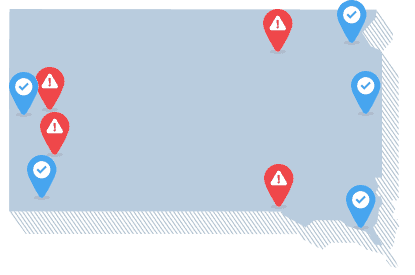The Safest and Most Dangerous Cities in South Dakota

South Dakota Security Solutions
The following is a list of cities that provide home security solutions in the state of South Dakota
The geographic center of the United States is in South Dakota (specifically, just outside of Belle Fourche) — so it’s fitting South Dakota is in the middle of the country for overall crime.1
South Dakota is ranked 24th in the United States for violent crime and 33rd for property crime (a higher number indicates a lower crime rate). Even better, both violent crime and property crime are dropping significantly each year.
South Dakota cities with the highest and lowest crime rates
(per 100,000 people)
| Cities with the highest property crime rates | |
|---|---|
| Wagner | 4,812 |
| Rapid City | 3,897 |
| Deadwood | 3,014 |
| Cities with the highest violent crime rates | |
|---|---|
| Rapid City | 742 |
| Aberdeen | 502 |
| Wagner | 495 |
| Cities with the lowest property crime rates | |
|---|---|
| Hot Springs | 244 |
| Elk Point | 432 |
| Lead | 495 |
| Cities with the lowest violent crime rates | |
|---|---|
| Hot Springs | 81 |
| Sisseton | 84 |
| Brookings | 103 |
Note: Excluding cities with crime rates of zero. Source: 2023 FBI Data
Best and Worst Cities for Property and Violent Crime
Interestingly, the three most violent cities in South Dakota are in three opposite ends of the state: Rapid City, Aberdeen, and Wagner have more violent crimes per 100,000 residents than anywhere else in South Dakota, according to the FBI.
Two of these three cities also score poorly for property crime: Both Rapid City and Wagner have some of the highest property crime and violent crime rates in the state.
Rapid City
Statewide, South Dakota has an average of 350 violent crimes per 100,000 residents. Rapid City has more than double that number, with 742 per 100,000 residents.
Rapid City is the second-worst city in the state for property crime, trailing just behind Wagner. Those numbers may sound tough, but the Rapid City Police Department reports violence is at its lowest level since 2020 — so things appear to be improving.2
Aberdeen
South Dakota’s third-largest city, Aberdeen, narrowly takes second place ahead of Wagner. Unfortunately, Aberdeen’s law enforcement agency is noticing an uptick in crime. According to the Aberdeen Police Department, calls for DUIs, intoxicated persons, disturbances, fights, and mental health issues have all increased in recent years.3
Wagner
With a population of just 1,500, Wagner punches above its weight in crime. Wagner is the worst city in the state for property crime (4,812 per 100,000) and the third-worst for violent crime (495 per 100,000).
To help combat crime, Wagner recently implemented a curfew for minors.4 Each weeknight at 9:30 p.m., the city of Wagner blows a whistle, telling minors they have 30 minutes to get home. Curfew starts at 10 p.m. on weeknights and midnight on Friday and Saturday.
Deadwood
The tourist hotspot — and historically lawless — city of Deadwood also makes the podium as one of the three worst cities in the state for property crime. And no, property theft rates don’t include the one-armed bandits at Deadwood’s 20-plus casinos.
Safest Cities in South Dakota
It’s important to remember South Dakota is safer than the average state. Violent crime rates are 4 percent lower than the national average, while property crime rates are 16 percent below the national average. Even in its cities with the most criminal activity, there are good and bad areas.
Some cities, however, are consistently safer than others:
Hot Springs
Hot Springs has some of the best weather in South Dakota and is also the safest city. It has the lowest rates of violent crime (81 per 100,000 residents) and property crime (244 per 100,000 residents). The hardest part of living in Hot Springs might be finding an affordable place to live. In a recent survey, 70 percent of Hot Springs residents listed “housing” as a major concern, and schools and businesses are struggling with labor shortages as a result.5
Brookings
The home of South Dakota State University is the safest large city (20,000-plus people) in the state. In fact, every other safe city on this list has a population under 4,000, making Brookings’ low crime rates even more impressive.
Lead
While Deadwood has the third-highest property crime rate in the state, Lead, found just up the hill, has the third-lowest rate. Maybe that’s why someone recently paid a record $1 million for a single lot at Deer Mountain Village, an upscale residential development at the old ski hill outside of town.6
South Dakota vs. Other States
South Dakota has a slightly lower crime rate than the average state, sitting squarely in the middle of the pack at 24th for violent crime and 33rd for property crime.
Compared to the state’s neighbors, it is doing OK: North Dakota ranked 33rd for violent crime and 18th for property crime.
Montana, meanwhile, sits 11th for violent crime and 21st for property crime. Nebraska and Minnesota have similar rankings to South Dakota. Iowa does better-than-average at 32nd for violent crime and 43rd for property crime.
Which Crimes Are Most Common in South Dakota?
Murder, rape, aggravated assault, and robbery are all considered violent crimes.
Violent crime rates
(per 100,000 residents)
| Crime Type | South Dakota | National |
|---|---|---|
| Murder/Non-negligent homicide | 2.9 | 5.7 |
| Aggravated assault | 276.1 | 263.7 |
| Robbery | 20.4 | 65.4 |
| Rape | 50.3 | 38.0 |
That’s why stats can be quirky: South Dakota’s murder rate is 49.1 percent below the national average, but its violent crime rate is just 4 percent below the national average. In fact, South Dakota is well below average in all major crime categories but two:
- Rape is 32.4 percent above the national average
- Aggravated assault is 4.5 percent above the national average
- Burglary is 11.4 percent below the national average
- Larceny-theft is 14.5 percent below national average
- Vehicle theft is 23.2 percent below the national average
- Murder is 49.1 percent below the national average
- Robbery is 69.3 percent below the national average
The most common crimes in South Dakota are the most common crimes in most states: aggravated assault and larceny-theft.
Property crime rates
(per 100,000 residents)
| Crime Type | South Dakota | National |
|---|---|---|
| Burglary | 222.1 | 250.7 |
| Larceny | 1151.4 | 1343.9 |
| Vehicle theft | 244.9 | 317.2 |
It’s important to consider how population impacts rankings. With a population of under one million, South Dakota is more influenced by a single crime than other, more populous states. South Dakota reported just 18 total murders in 2023, for example.7 If South Dakota had two fewer — or two more — murders, it would change rankings significantly.
Plus, South Dakota is getting better:
- Violent crime dropped 7.3 percent over the last year
- Property crime dropped 6.8 percent over the last year
What’s causing crime? Crime is a complex issue in South Dakota. Some blame drug and alcohol addiction. Others blame lax parole policies or guns.8 Overall, compared to the rest of the country, we’re doing OK in the Mount Rushmore State, and there are signs of progress on the horizon as crime rates decline year over year.
Where Our Crime Data Comes From
Unless specified otherwise, the information in this article is based on crime data compiled by the FBI and made available through the Crime Data Explorer. Statewide violent and property crime statistics are drawn from the FBI’s 2023 Crime in the United States Report (Table 5), while metro area data comes from Table 6, which breaks down offenses by metropolitan statistical areas. For city-level crime rates, we referred to Table 8, which lists reported offenses by state and city.
Important note: Crime statistics offer valuable insights, but they aren’t the only way to evaluate a community’s safety. Local context, law enforcement practices, and reporting standards can all influence how crime is recorded. Additionally, FBI publication tables and the data displayed on the Crime Data Explorer may differ slightly due to variations in methodology.
Citations
- Travel South Dakota. (2024). Geographic Center of the Nation Monument.
https://www.travelsouthdakota.com/belle-fourche/national-state-parks/national-monument/geographic-center-nation-monument
- City of Rapid City. (2024, Jan 25). Rapid City Police Observe Five-Year Low in Violent Crimes.
https://www.rcgov.org/news/rapid-city-police-observe-five-year-low-in-violent-crimes-13794.html
- Dakota News Now. (2024, Jul 10). Aberdeen Police Department releases annual crime report.
https://www.dakotanewsnow.com/2024/07/10/aberdeen-police-department-releases-annual-crime-report/
- Dakota News Now. (2025, Feb 11). Wagner’s curfew whistle to be reinstated.
https://www.dakotanewsnow.com/2025/02/11/wagners-curfew-whistle-be-reinstated/
- South Dakota News Watch. (2024). Resident-driven ideas at heart of Engage South Dakota.
https://www.sdnewswatch.org/resident-driven-ideas-at-heart-of-engage-south-dakota/
- KELOLAND News. (2024, Nov 21). 1 acre property sells for $1 million near Lead, SD.
https://www.keloland.com/keloland-com-original/1-acre-property-sells-for-1-million-near-lead-sd/ - South Dakota Incident-Based Reporting System. (2024). South Dakota Crime Dashboard.
https://sdcrime.nibrs.com/ - Dakota News Now. (2022, Sept 20). Guns, drugs and lax paroles to blame for violent crime in Sioux Falls, officials say.
https://www.dakotanewsnow.com/2022/09/20/guns-drugs-lax-paroles-blame-violent-crime-sioux-falls-officials-say
